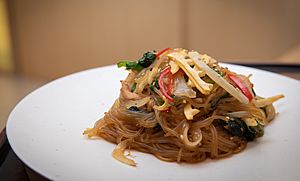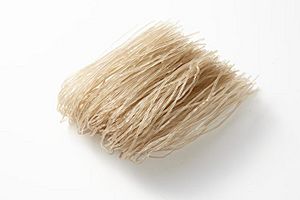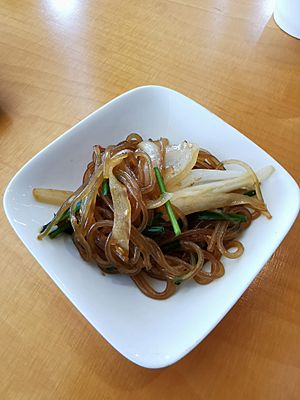Japchae facts for kids
 |
|
| Place of origin | Korea |
|---|---|
| Associated national cuisine | Korean cuisine |
| Serving temperature | 50–65 °C (122–149 °F) |
| Main ingredients | Sweet potato starch noodles |
| Korean name | |
| Hangul |
잡채
|
|---|---|
| Hanja |
雜菜
|
| Revised Romanization | japchae |
| McCune–Reischauer | chapch'ae |
| IPA | [tɕap̚.tɕʰɛ] |
Japchae (잡채; 雜菜) is a yummy and slightly sweet Korean dish. It's made with stir-fried glass noodles and lots of colorful vegetables. This popular food is a big part of Korean cuisine.
Japchae usually uses dangmyeon, which are noodles made from sweet potato starch. These noodles are mixed with different vegetables, meat, and mushrooms. The dish gets its great taste from soy sauce and sesame oil.
Long ago, japchae was a special dish served to kings. Today, it's a favorite for celebrations. People often eat it at weddings, birthdays, and holidays. It's also great for parties because it's easy to make a lot. You can enjoy japchae warm, at room temperature, or even cold from the fridge. It tastes good fresh or the next day!
Japchae is often served as a banchan (a small side dish). But you can also eat it as a main meal. Sometimes, it's served over rice, and then it's called japchae-bap (잡채밥).
Contents
What's in the Name and Its History?
The name japchae (잡채) comes from two Korean words. Jap (잡) means "mixed," and chae (채) means "vegetable." So, japchae literally means "mixed vegetables."
The story of japchae began a long time ago, in the early 1600s. A man named Yi Chung made this dish for King Gwanghaegun's palace party. The king loved it so much that he gave Yi Chung a very important job!
Because the king enjoyed it, japchae became a regular dish in the royal palace. Back then, it was made only with stir-fried vegetables and mushrooms. There were no noodles or meat in it. It was a fancy dish for the royal family and important people. Vegetables like cucumbers, radishes, and shiitake mushrooms were common ingredients.
Over time, japchae became popular with everyone, not just the royal family. Its popularity grew even more in the 1900s. This was when cellophane noodles made from sweet potato starch came to Korea from China. These noodles quickly became the most important part of japchae. People started adding beef and other meats to the noodle dish. Now, there are many different kinds of japchae, some even made with seafood or different peppers.
How Is Japchae Made?
The main noodles in japchae are called dangmyeon. They are a pale grey color and look a bit see-through. These noodles are chewy and springy, made from sweet potato starch. People also call them "glass noodles" or "cellophane noodles."
Before cooking, the noodles are often soaked in water. Sometimes, they are soaked in hot water and then stir-fried. Japchae can have many different vegetables. Common ones include mushrooms, carrots, spinach, onions, egg, and scallions. Popular mushrooms are wood ear, shiitake, and oyster mushrooms.
You can use either beef or pork in japchae. Each ingredient, like the vegetables and meat, is stir-fried separately. Then, they are all mixed together with the cooked and drained noodles. The dish is seasoned with soy sauce, sugar, chopped garlic, and sesame oil. Finally, japchae is often topped with toasted sesame seeds and thin chili threads. It can be served warm or cold.
Different Kinds of Japchae
There are many fun varieties of japchae! Some are based on the old royal recipes, while others are more modern.
Royal Court Styles
- Gyeoja-chae (겨자채)
- Jokchae (족채) – Made with shredded jelly from pig's trotters and vegetables.
- Tangpyeong-chae (탕평채) – This one uses nokdu-muk (mung bean jelly), beef, mung bean sprouts, and other greens.
- Wolgwa-chae (월과채) – Made with a type of melon, beef, and vegetables.
- Juksoon-chae (죽순채) - Features bamboo shoots and vegetables.
Other Popular Styles
- Gochu-japchae (고추잡채) – Made with shredded green peppers and vegetables.
- Buchu-japchae (부추잡채) – Uses garlic chives for a unique flavor.
- Kongnamul-japchae (콩나물잡채) – Made with soybean sprouts.
- Haemul-japchae (해물잡채) – This version includes delicious seafood and vegetables.
- Beoseot-japchae (버섯잡채) – Focuses on different kinds of mushrooms.
- Gungjung-japchae (궁중잡채) - A fancy version made with high-quality ingredients, like the royal dishes.
See also
 In Spanish: Japchae para niños
In Spanish: Japchae para niños



